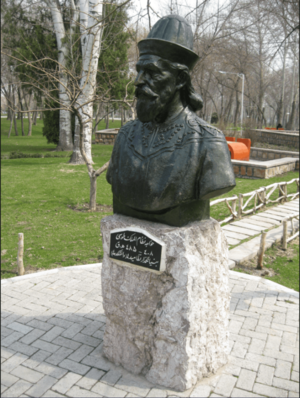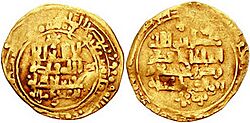Nizam al-Mulk facts for kids
Quick facts for kids
Nizam al-Mulk
|
|
|---|---|
 |
|
| Vizier of the Seljuk Empire | |
| In office 29 November 1064 – 14 October 1092 |
|
| Monarch | Alp Arslan, Malik Shah I |
| Preceded by | Al-Kunduri |
| Succeeded by | Taj al-Mulk Abu'l Ghana'im |
| Personal details | |
| Born | April 10, 1018 Tus, Ghaznavid Empire |
| Died | October 14, 1092 (aged 74) Nahavand, Seljuk Empire |
| Spouse | Unnamed Bagrationi princess |
| Children | Ahmad ibn Nizam al-Mulk Shams al-Mulk Uthman Abulfath Fakhr al-Malik Mu'ayyid al-Mulk Jamal al-Mulk Fakhr al-Mulk Izz al-Mulk Imad al-Mulk Abu'l-Kasim Safiyya |
Nizam al-Mulk (born April 10, 1018 – died October 14, 1092) was a very important Persian scholar and vizier (a high-ranking government official, like a prime minister) of the Seljuk Empire. His full name was Abu Ali Hasan ibn Ali Tusi. His title, Nizam al-Mulk, means "Orderer of the Realm" in Persian.
He started from a low position and rose to become the most powerful person in the Seljuk Empire after the Sultan. He was like the de facto (actual) ruler for 20 years. Many historians see him as one of the most important leaders in Islamic history. The way he organized the government became a model for many Muslim countries for centuries.
One of his greatest achievements was creating a network of schools called the Nizamiyyas. These schools were named after him and were built in many cities across the Seljuk Empire. He also wrote a famous book called Siyasatnama (Book of Government). This book shared his ideas on how to rule fairly and effectively.
Contents
Early Life and First Job
Abu Ali Hasan was born on April 10, 1018. His birthplace was a small village called Radkan, near Tus, in Iran. His family were dehqans, which means they were landowners. He studied Islamic law and theology as he grew up.
His father, Ali ibn Ishak, worked as a financial officer for the Ghaznavids. But in 1040, the Seljuk Turks defeated the Ghaznavids in the Battle of Dandanaqan. The Seljuks then took control of Khorasan. Abu Ali Hasan's father moved to Ghazni, and Hasan followed him. This is where Hasan got his first job in government. After about three or four years, he left the Ghaznavid court and started working for the Seljuks.
Working for the Seljuks
Serving Sultan Alp Arslan
Around 1043, Abu Ali Hasan began working for the Seljuk Turks. By 1059, he became the main administrator for the entire Khorasan province. When the Seljuk Sultan Tughril died, his nephew Alp Arslan became the new Sultan. Abu Ali Hasan helped Alp Arslan secure his power.
After Alp Arslan became Sultan in 1064, he made Abu Ali Hasan his vizier. This was a very important job. It was then that Abu Ali Hasan received the special title "Nizam al-Mulk," meaning "Order of the Realm." He kept this powerful position throughout the reigns of Alp Arslan (1063–1072) and his son, Malik-Shah I (1072–1092).
Alp Arslan was a strong military leader. But Nizam al-Mulk was in charge of running the country's daily affairs. He created a strong government system that helped the Seljuk Empire grow. He set up military iqtā’ (fiefs or land grants) for soldiers. This helped support the army and settled the nomadic Turks into the agricultural areas. This system allowed the Seljuks to have a large army without relying only on money from conquests.
Nizam al-Mulk often traveled with Alp Arslan on his military campaigns. In 1064, they campaigned in Byzantine Armenia and captured the city of Ani. They also went into the Caucasus region, reaching Georgia. Nizam al-Mulk also led some expeditions on his own. He captured the citadel of Estakhr in 1067. He was not present at the famous Battle of Manzikert in 1071, as he was sent to Persia with supplies.
Serving Sultan Malik Shah I

After Alp Arslan was killed in 1072, his son Malik-Shah I became Sultan. Malik-Shah I had to fight his uncle, Kavurt, for the throne. In 1074, their armies met near Hamadan. Malik-Shah I's army won, and Kavurt was killed. Many believe Nizam al-Mulk ordered this.
Under Nizam al-Mulk's skilled leadership, the Seljuk Empire became even stronger. Their armies kept the Ghaznavids in check and pushed back the Fatimids in Syria. They also defeated other rivals and made Georgia a state that paid tribute. Nizam al-Mulk made sure that local rulers stayed loyal to the Sultan. He also kept good relations with the Abbasid Caliphate.
Nizam al-Mulk was known for bringing "Order of the Realm" to the Seljuk government. He helped bridge differences between the Abbasids, the Seljuks, and their rivals. The Seljuk army had soldiers from many different backgrounds. But Nizam al-Mulk preferred Iranian soldiers and also favored soldiers from Georgia.
Nizam al-Mulk had several important goals for the empire:
- He wanted to create jobs for the Turkmens who had moved to the Iranian plateau. Their nomadic lifestyle could cause problems for the country's stability.
- He wanted to show the Sultan's power, both through military strength and kindness to those who surrendered.
- He aimed to keep local Sunni and Shiite rulers as loyal subjects of the Sultan. He also encouraged the Sultan's relatives to become provincial governors.
- He worked to prevent disagreements about who would become Sultan after Malik-Shah I.
- He wanted to maintain strong ties with the Abbasid Caliphate.
Later, some people tried to harm Nizam al-Mulk. In 1081 or 1082, one of his enemies tried to poison him but failed. Nizam's enemies also spread false stories about him and his son. This made Nizam's son, Jamal al-Mulk, very angry. Jamal punished one of the people spreading lies. Sultan Malik Shah I could not stop this, and Jamal later died mysteriously.
In 1091, a group called the Isma'ilis captured the Alamut fortress. This caused more trouble. Malik-Shah I had two older sons who died, and his wife, Terken Khatun, wanted her younger son, Mahmud, to be the next Sultan. But Nizam al-Mulk and most of the army supported Barkiyaruq, Malik-Shah's oldest living son. Terken Khatun then teamed up with Taj al-Mulk to try and get Nizam fired. Taj even accused Nizam of being corrupt. However, Malik Shah I did not remove Nizam from his position. Nizam later tried to capture Alamut but had to retreat.
In 1092, just before his death, Nizam al-Mulk knew his enemies were plotting against him. He gave a famous speech to the court:
Tell the Sultan, If you have not already realized that I am your co-equal in the work of ruling, then know that you have only attained to this power through my statesmanship and judgement. Does he not remember when his father was killed, and I assumed responsibility for the conduct of affairs and crushed the rebels who reared their heads, from his own family and from elsewhere. Tell him that the stability of that regal cap is bound up with this vizierial inkstand, and that the harmony of these two interests is the means of securing all objects soughts after and the ultimate cause of all objects gained. If ever I close up this inkstand, that royal power will topple.
His Important Works
Nizam al-Mulk was not just a powerful vizier; he also created a system of higher education. He founded many famous schools called the Nizamiyyah schools. These schools were built in cities like Baghdad, Isfahan, Nishapur, and Herat. They were named after him and became very important centers of learning.
He is also well-known for his large book on how to be a good ruler, called Siyasatnama (Book of Government). Sultan Malik Shah had asked his ministers to write books about government. Nizam's book was the only one approved. It became like "the law of the constitution of the nation." The book uses historical examples to talk about fairness, effective leadership, and the government's role in Islamic society. It has been compared to The Prince by Machiavelli. The book also talks about the importance of having a good network of spies to keep the country safe.
He also wrote another book called Dastur al-Wuzarā, which was for his son, Abu'l-Fath Fakhr al-Malik.
Death
Nizam al-Mulk was killed on October 14, 1092. He was traveling from Isfahan to Baghdad. Most historical accounts say he was assassinated by a member of the Assassins, a secret group led by Hassan-i Sabbah. This happened near Nahavand while he was being carried in his litter (a type of covered stretcher).
His Lasting Impact
Nizam al-Mulk was a very skilled and effective vizier. He was known for his grand style, generosity, and ability to organize. Historians and poets described him as a great leader, soldier, and scholar. Because of his talents, the Seljuk Turks were able to build a powerful empire in their new home.
Nizam was not only the head of the Persian government offices, but he also played a key role between the different cultures of the Iranians and Turks. He was responsible for setting up specific Persian ways of government and administration that lasted for hundreds of years. Because he was such a good teacher and close friend to Malik-Shah, the Sultan often called him "father." Even his own personal guards respected him greatly. After Nizam's death, they took revenge on some of his rivals.
Even after he died, his family continued to be important in the Seljuk Empire. He was married to a niece or daughter of Bagrat IV of Georgia. All twelve of his sons held important positions in the Seljuk Empire. For example, Ahmad ibn Nizam al-Mulk became a vizier for a Seljuk Sultan and an Abbasid caliph. Other sons also served as governors or viziers in different parts of the empire.

